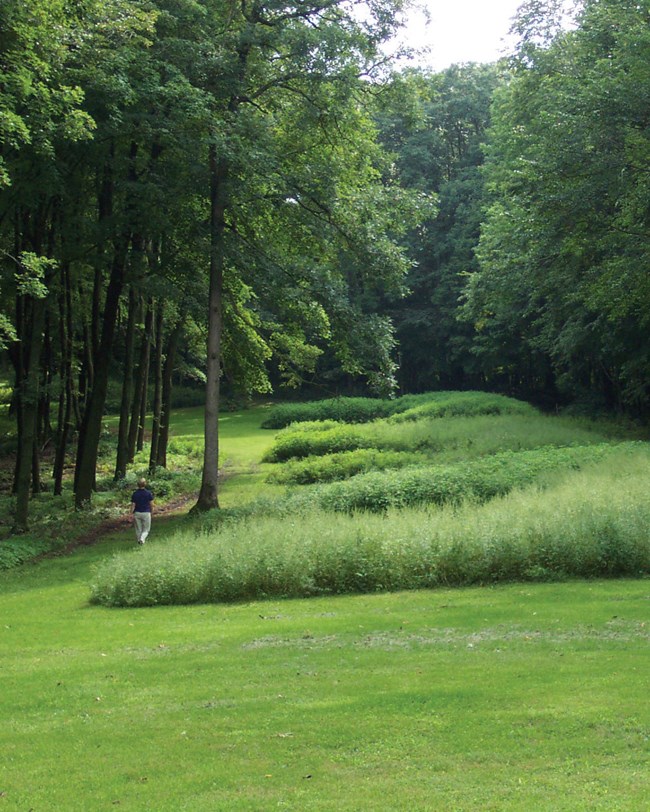Last updated: June 17, 2024
Article
NPS Geodiversity Atlas—Effigy Mounds National Monument, Iowa
Geodiversity refers to the full variety of natural geologic (rocks, minerals, sediments, fossils, landforms, and physical processes) and soil resources and processes that occur in the park. A product of the Geologic Resources Inventory, the NPS Geodiversity Atlas delivers information in support of education, Geoconservation, and integrated management of living (biotic) and non-living (abiotic) components of the ecosystem.

Introduction
Effigy Mounds National Monument (EFMO) is situated along the Mississippi River about 72 km (45 mi) northwest of Dubuque in Allamakee and Clayton Counties, northeastern Iowa. Proclaimed on October 25, 1949, EFMO contains approximately 1,022 hectares (2,526 acres) and preserves nationally significant archeological resources comprising one of the largest concentrations of prehistoric burial mounds in the United States (National Park Service 2014, 2016a). The national monument contains 206 mound sites, including 31 effigy mounds that were built in the shape of birds or bears. Constructed during the Late Woodland Period between 450 B.C.E. and 1300 C.E., the mound sites provide insight into the social, spiritual, and ceremonial practices of an ancient people known today as the Effigy Moundbuilders. The mound sites represent a significant phase in moundbuilding culture and are speculated to commemorate deceased loved ones and serve as sacred sites (National Park Service 2016a). Effigy Mounds National Monument consists of four individual sites that include the North Unit, South Unit, Heritage Addition, and Sny Magill Unit. The North Unit contains the monument headquarters, visitor center, Little Bear Mound, Great Bear Mound (largest effigy mound in EFMO), and numerous mound groups. The Marching Bear Group of mounds are preserved in the South Unit, a renowned group composed of ten bear and three bird effigies (O’Bright 1990). Added in 2000, the Heritage Addition contains five known mounds, five precontact stone quarries, and four historic sites. The Sny Magill Unit is located about 16 km (10 mi) south of the monument headquarters and contains more than 100 mounds, the highest concentration known in the region (National Park Service 2014).
Geologic Setting
The bedrock geology of EFMO consists of Cambrian and Ordovician sedimentary rocks. The landscape of the North Unit, South Unit, and Heritage Addition of EFMO is heavily influenced by the Yellow River and its tributaries. Flanking the Yellow River is a diverse stratigraphy of Ordovician rocks that consists of the Oneota Formation, Shakopee Formation, St. Peter Sandstone, Glenwood Formation, Platteville Formation, and Decorah Formation. The Sny McGill Unit is underlain entirely by the St. Peter Sandstone. The youngest rocks mapped within EFMO represent the Ordovician Dunleith Formation in the westernmost portion of the Heritage Addition and the southernmost area of the South Unit. The oldest rocks in EFMO consist of Cambrian formations (Jordan Sandstone, St. Lawrence Formation, Lone Rock Formation) exposed along the course of the Yellow River.
Regional Geology
Effigy Mounds National Monument is a part of the Central Lowland Physiographic Province and shares its geologic history and some characteristic geologic formations with a region that extends well beyond park boundaries.
- Scoping summaries are records of scoping meetings where NPS staff and local geologists determined the park’s geologic mapping plan and what content should be included in the report.
- Digital geologic maps include files for viewing in GIS software, a guide to using the data, and a document with ancillary map information. Newer products also include data viewable in Google Earth and online map services.
- Reports use the maps to discuss the park’s setting and significance, notable geologic features and processes, geologic resource management issues, and geologic history.
- Posters are a static view of the GIS data in PDF format. Newer posters include aerial imagery or shaded relief and other park information. They are also included with the reports.
- Projects list basic information about the program and all products available for a park.
Source: NPS DataStore Saved Search 2815. To search for additional information, visit the NPS DataStore.
A NPS Soil Resources Inventory project has been completed for Effigy Mounds National Monument and can be found on the NPS Data Store.
Source: NPS DataStore Saved Search 2824. To search for additional information, visit the NPS DataStore.

Related Links
